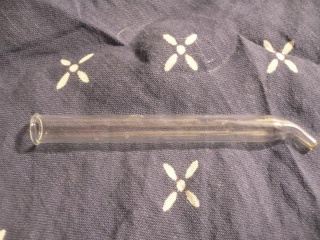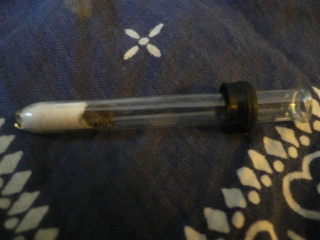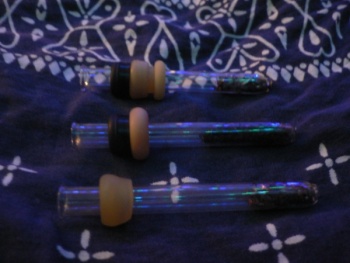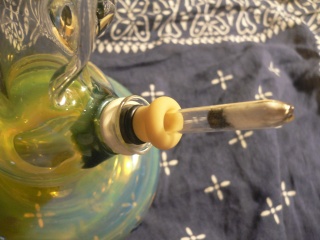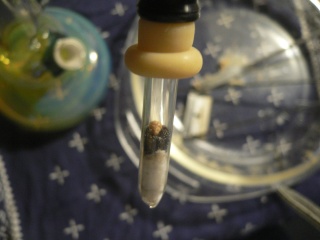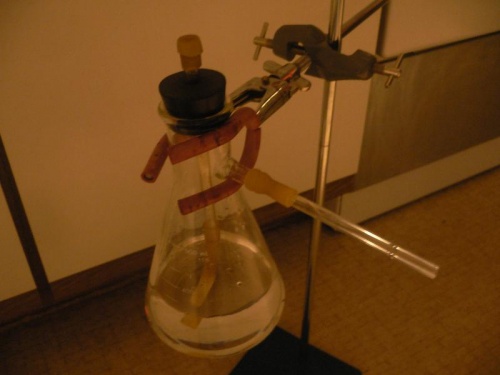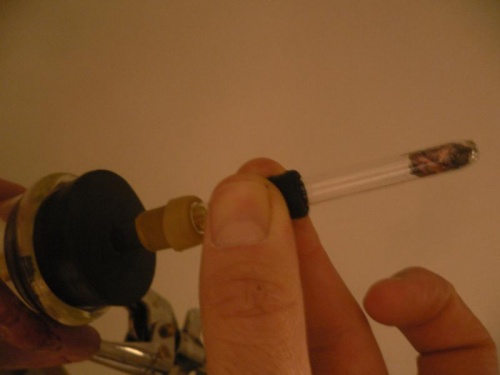Difference between revisions of "The Inspirator"
From DMT-Nexus Wiki
m |
(created tek, photos on the way) |
||
| Line 6: | Line 6: | ||
:# One who inspires or motivates others. | :# One who inspires or motivates others. | ||
<nowiki>[From Late Latin, from inspirare 'to inspire' (from in- + spirare 'to breathe') + -tor; cognate with, and possibly derived via, English or German]</nowiki> | <nowiki>[From Late Latin, from inspirare 'to inspire' (from in- + spirare 'to breathe') + -tor; cognate with, and possibly derived via, English or German]</nowiki> | ||
| + | |||
| + | ==== Procedure for Construction ==== | ||
| + | |||
| + | {{materials_list | ||
| + | | | ||
| + | | | ||
| + | | | ||
| + | | | ||
| + | * Butane Torch (same one that will be used for vaporization) | ||
| + | * Glass Dropper Stem (either from a pharmacy OTC or an online vendor) | ||
| + | * Ceramic Fiber (in any form, often found as blankets) | ||
| + | * Copper or Stainless Steel Pan Scrubber (as long as the metal doesn't burn or melt with the use of a butane torch) | ||
| + | * A Thin Metal Rod (even a paper clip would probably work) | ||
| + | * Safety Pin (long enough to punch holes through the plug) | ||
| + | * Pliers | ||
| + | * Rubber Gasket and/or Latex Tubing | ||
| + | }} | ||
| + | <table> | ||
| + | <tr> | ||
| + | <td>[[Image:P1050415.JPG|thumb|center|320px|Dropper Stem]]</td> | ||
| + | <td>[[Image:The_Inspirator.JPG|thumb|center|320px|Complete Mini-Machine Bubbler Stem]]</td> | ||
| + | </tr> | ||
| + | </table> | ||
| + | [[Image:P1050511.JPG|thumb|350px|Some variations in gasket design.]] | ||
| + | # Carefully crush the nozzle of the dropper stem with pliers, leaving a slight portion of the nozzle's curve. | ||
| + | # Melt the broken end of the stem with a torch so that the sharp edges are dulled and any cracks sealed. | ||
| + | # Cut a segment of ceramic fiber, and use a thin metal rod to stuff it down toward the nozzle-end somewhat snuggly, and so that a part of the ceramic is exposed out of the broken end. | ||
| + | # Cut off a minimal piece of the metal scrub pad, hold it with pliers, and burn with a torch under an oven hood until no more smoke is emitted. | ||
| + | # After it has cooled, stuff it in the larger end of the dropper stem and down toward the ceramic to lock it in place. | ||
| + | # Fit two gaskets on the stem far enough from the plug to avoid heat but far enough from the other end to provide a stable stem. | ||
| + | #* ''alternatively and more cheaply, a small section of latex tubing could be rolled or folded into a ring around the stem to serve the same purpose.'' | ||
| + | # Use a safety pin to punch holes through the ceramic/copper plug while holding the plug in place to ensure adequate airflow. | ||
| + | #* ''there should be some amount of pressure but no strain on the draw.'' | ||
| + | # To further improve airflow, insert the piece into a bubbler and use a safety pin to work the ceramic fiber around until the draw becomes significantly easier. | ||
| + | #* ''airflow is the key factor in ensuring the quality and effectiveness of the device.'' | ||
| + | |||
| + | ==== Administration. ==== | ||
| + | |||
| + | # Place product into the open end of the stem and stuff down to the plug with a thin metal rod. | ||
| + | # Feather the glass with a torch until the product melts into the mesh plug. | ||
| + | # Insert the stem into a bubbler as a bowl, with the open end in. | ||
| + | # Use a torch to apply heat to the exposed ceramic portion of the plug while drawing air through the bubbler. | ||
| + | #* ''keeping some distance with the torch is recommended to avoiding burning or overheating.'' | ||
| + | # Only apply heat until a decent amount of vapor can be observed in the chamber, carb the bubbler immediately but briefly, and continue to apply heat and inhale in the same manner. | ||
| + | #* ''once the device reaches a sufficient temperature, it will give off vapor rapidly and will not necessarily require continued heat application, but continue to heat periodically during to ensure complete vaporization.'' | ||
| + | <table> | ||
| + | <tr> | ||
| + | <td>[[Image:Inspirator_bubbler.JPG|thumb|center|320px|Seated in a bubbler.]]</td> | ||
| + | <td>[[Image:Inspirator_load.JPG|thumb|center|320px|Loading the device.]]</td> | ||
| + | </tr> | ||
| + | </table> | ||
| + | |||
| + | |||
| + | |||
| + | {{procedure | ||
| + | |Use with an Improvised Labware Bubbler | ||
| + | | | ||
| + | {{ShowInfo/In Article|[[Image:Information.png]]|'''NOTE'''|Though a slightly different design is pictured, this design is to be used in the same manner. | ||
| + | |0px | ||
| + | | | ||
| + | }} | ||
| + | <table> | ||
| + | <tr> | ||
| + | <td>[[Image:P1050449.JPG|thumb|center|500px|The mouthpiece is a longer dropper tube (Pasteur pipette) connected to the nozzle of the vacuum flask by another segment of latex tubing.]]</td> | ||
| + | <td>[[Image:P1050452.JPG|thumb|center|500px|The segment of latex on the top of the inlet is folded over itself to make a wide even rim to facilitate a proper seal with the glass rim of the dropper stem when held in place.]]</td> | ||
| + | </tr> | ||
| + | </table> | ||
| + | }} | ||
| + | |||
| + | ==== Notes on Effective Use and Maintenance ==== | ||
| + | |||
| + | {{Procedure | ||
| + | |for Cleaning the Mini-Machine | ||
| + | | | ||
| + | {{ShowInfo/In Article|[[Image:Information.png]]|'''NOTE'''|Though acetone works well for this, it can be dangerous in terms of inhalation of fumes and potential fire hazard. A good nontoxic alternative is to use vinegar to clean the piece, then a sodium carbonate solution to neutralize the acetic acid in the vinegar, then water to wash out any residual base or salts. Heat application may help to remove residual moisture from the plug. | ||
| + | |0px | ||
| + | | | ||
| + | }} | ||
| + | # ''Attach a chemically resistant dropper bulb to the open end.'' | ||
| + | # ''Prepare a flask of cleaning solvent.'' | ||
| + | # ''Draw in the solvent and squirt out through the plug until sufficiently clean.'' | ||
| + | #* <small>''actives may potentially be salvaged from cleaning solvent collected over time.''</small> | ||
| + | # ''Scrub with a q-tip.'' | ||
| + | # ''Carefully blow out remaining solvent.'' | ||
| + | # ''Scrub out moisture with the other end of the q-tip.'' | ||
| + | # ''Ensure the absence of residual solvent prior to use.'' | ||
| + | }} | ||
| + | |||
| + | * A handy method for storing the piece would be to cap the nozzle end with the dropper bulb in order to protect from breakage and keep track of the bulb to use when cleaning. | ||
| + | * The second gasket generally makes the piece safer to handle--especially if used as a pull stem--while the other provides a seal. | ||
| + | * For group sessions, it would be easiest to prepare an individual piece for each person so that dosage can be more easily regulated. | ||
| + | * When handling the piece after heating, handle by the gasket and avoid any part of the heated portion of the glass coming into any contact with hard surfaces. | ||
| + | * A good way to cool down a stem is to roll it rapidly between the palms, drawing the heat off the glass with one's hands. | ||
| + | * If the the nozzle end of the piece breaks off at any point, carefully push the plug to the other end of the piece when it has sufficiently cooled, heat the sharp edges until dulled, and push the plug back into place firmly, with a finger in place causing the plug to mushroom slightly until it fits snugly in place. | ||
| + | * Ensure adequate airflow through the piece by poking holes in the plug with a safety pin. | ||
| + | * Develop a relationship with the device. | ||
| + | </onlyinclude> | ||
| + | |||
| + | ==== Appendices ==== | ||
| + | |||
| + | : Special Thanks: | ||
| + | :* To Warrensaged for pioneering the use of a machine-style bowl with a bubbler. | ||
| + | :* To q21q21 for inspiring SWIM to develop this method. | ||
== Reference == | == Reference == | ||
{{Page Footer|Administration Tek|DMT}} | {{Page Footer|Administration Tek|DMT}} | ||
Revision as of 18:39, 20 January 2010
| Note: | This page tracks the development of The Inspirator[1]. The content is to remain accurate as such. |
in·spi·ra·tor (ĭn'spə-rā'tər) n.
- A device, such as a respirator or inhaler, by which a gas, vapor, or air is drawn in.
- One who inspires or motivates others.
[From Late Latin, from inspirare 'to inspire' (from in- + spirare 'to breathe') + -tor; cognate with, and possibly derived via, English or German]
Contents
Procedure for Construction
- Carefully crush the nozzle of the dropper stem with pliers, leaving a slight portion of the nozzle's curve.
- Melt the broken end of the stem with a torch so that the sharp edges are dulled and any cracks sealed.
- Cut a segment of ceramic fiber, and use a thin metal rod to stuff it down toward the nozzle-end somewhat snuggly, and so that a part of the ceramic is exposed out of the broken end.
- Cut off a minimal piece of the metal scrub pad, hold it with pliers, and burn with a torch under an oven hood until no more smoke is emitted.
- After it has cooled, stuff it in the larger end of the dropper stem and down toward the ceramic to lock it in place.
- Fit two gaskets on the stem far enough from the plug to avoid heat but far enough from the other end to provide a stable stem.
- alternatively and more cheaply, a small section of latex tubing could be rolled or folded into a ring around the stem to serve the same purpose.
- Use a safety pin to punch holes through the ceramic/copper plug while holding the plug in place to ensure adequate airflow.
- there should be some amount of pressure but no strain on the draw.
- To further improve airflow, insert the piece into a bubbler and use a safety pin to work the ceramic fiber around until the draw becomes significantly easier.
- airflow is the key factor in ensuring the quality and effectiveness of the device.
Administration.
- Place product into the open end of the stem and stuff down to the plug with a thin metal rod.
- Feather the glass with a torch until the product melts into the mesh plug.
- Insert the stem into a bubbler as a bowl, with the open end in.
- Use a torch to apply heat to the exposed ceramic portion of the plug while drawing air through the bubbler.
- keeping some distance with the torch is recommended to avoiding burning or overheating.
- Only apply heat until a decent amount of vapor can be observed in the chamber, carb the bubbler immediately but briefly, and continue to apply heat and inhale in the same manner.
- once the device reaches a sufficient temperature, it will give off vapor rapidly and will not necessarily require continued heat application, but continue to heat periodically during to ensure complete vaporization.
| Use with an Improvised Labware Bubbler | ||||||
|---|---|---|---|---|---|---|
|
Notes on Effective Use and Maintenance
- A handy method for storing the piece would be to cap the nozzle end with the dropper bulb in order to protect from breakage and keep track of the bulb to use when cleaning.
- The second gasket generally makes the piece safer to handle--especially if used as a pull stem--while the other provides a seal.
- For group sessions, it would be easiest to prepare an individual piece for each person so that dosage can be more easily regulated.
- When handling the piece after heating, handle by the gasket and avoid any part of the heated portion of the glass coming into any contact with hard surfaces.
- A good way to cool down a stem is to roll it rapidly between the palms, drawing the heat off the glass with one's hands.
- If the the nozzle end of the piece breaks off at any point, carefully push the plug to the other end of the piece when it has sufficiently cooled, heat the sharp edges until dulled, and push the plug back into place firmly, with a finger in place causing the plug to mushroom slightly until it fits snugly in place.
- Ensure adequate airflow through the piece by poking holes in the plug with a safety pin.
- Develop a relationship with the device.
Appendices
- Special Thanks:
- To Warrensaged for pioneering the use of a machine-style bowl with a bubbler.
- To q21q21 for inspiring SWIM to develop this method.
